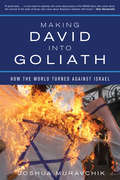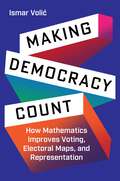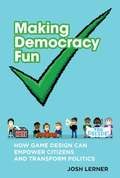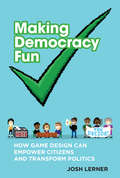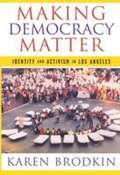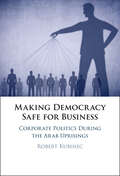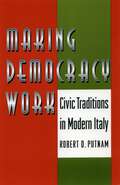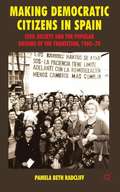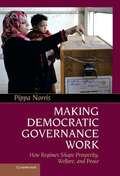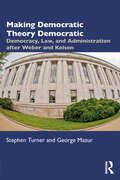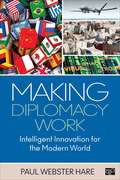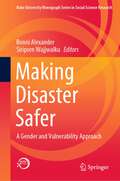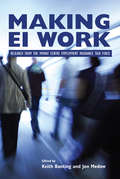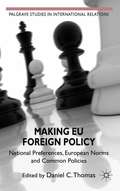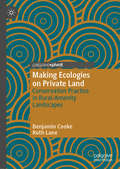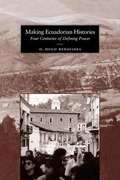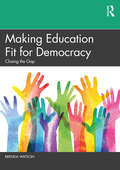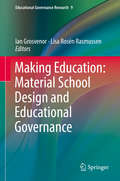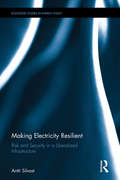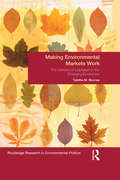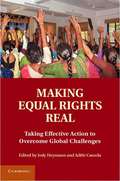- Table View
- List View
Making David into Goliath
by Joshua MuravchikDuring the Six Day War of 1967, polls showed that Americans favored the Israelis over the Arabs by overwhelming margins. In Europe, support for Israel ran even higher. In the United Nations Security Council, a British resolution essentially gave Israel the terms of peace it sought and when the Arabs and their Soviet supporters tried to override the resolution in the General Assembly, they fell short of the necessary votes.Fast forward 40 years and Israel has become perhaps the most reviled country in the world. Although Americans have remained constant in their sympathy for the Jewish state, almost all of the rest of the world treats Israel as a pariah.What caused this remarkable turnabout? Making David into Goliath traces the process by which material pressures and intellectual fashions reshaped world opinion of Israel. Initially, terrorism, oil blackmail, and the sheer size of Arab and Muslim populations gave the world powerful inducements to back the Arab cause. Then, a prevalent new paradigm of Leftist orthodoxy, in which class struggle was supplanted by the noble struggles of people of color, created a lexicon of rationales for taking sides against Israel. Thus, nations can behave cravenly while striking a high-minded pose in aligning themselves on the Middle East conflict.
Making Democracy Count: How Mathematics Improves Voting, Electoral Maps, and Representation
by Ismar VolićHow we can repair our democracy by rebuilding the mechanisms that power itWhat’s the best way to determine what most voters want when multiple candidates are running? What’s the fairest way to allocate legislative seats to different constituencies? What’s the least distorted way to draw voting districts? Not the way we do things now. Democracy is mathematical to its very foundations. Yet most of the methods in use are a historical grab bag of the shortsighted, the cynical, the innumerate, and the outright discriminatory. Making Democracy Count sheds new light on our electoral systems, revealing how a deeper understanding of their mathematics is the key to creating civic infrastructure that works for everyone.In this timely guide, Ismar Volić empowers us to use mathematical thinking as an objective, nonpartisan framework that rises above the noise and rancor of today’s divided public square. Examining our representative democracy using powerful clarifying concepts, Volić shows why our current voting system stifles political diversity, why the size of the House of Representatives contributes to its paralysis, why gerrymandering is a sinister instrument that entrenches partisanship and disenfranchisement, why the Electoral College must be rethought, and what can work better and why. Volić also discusses the legal and constitutional practicalities involved and proposes a road map for repairing the mathematical structures that undergird representative government.Making Democracy Count gives us the concrete knowledge and the confidence to advocate for a more just, equitable, and inclusive democracy.
Making Democracy Fun
by Josh LernerAnyone who has ever been to a public hearing or community meeting would agree that participatory democracy can be boring. Hours of repetitive presentations, alternatingly alarmist or complacent, for or against, accompanied by constant heckling, often with no clear outcome or decision. Is this the best democracy can offer? In Making Democracy Fun, Josh Lerner offers a novel solution for the sad state of our deliberative democracy: the power of good game design. What if public meetings featured competition and collaboration (such as team challenges), clear rules (presented and modeled in multiple ways), measurable progress (such as scores and levels), and engaging sounds and visuals? These game mechanics would make meetings more effective and more enjoyable -- even fun. Lerner reports that institutions as diverse as the United Nations, the U.S. Army, and grassroots community groups are already using games and game-like processes to encourage participation. Drawing on more than a decade of practical experience and extensive research, he explains how games have been integrated into a variety of public programs in North and South America. He offers rich stories of game techniques in action, in children's councils, social service programs, and participatory budgeting and planning. With these real-world examples in mind, Lerner describes five kinds of games and twenty-six game mechanics that are especially relevant for democracy. He finds that when governments and organizations use games and design their programs to be more like games, public participation becomes more attractive, effective, and transparent. Game design can make democracy fun -- and make it work.
Making Democracy Fun: How Game Design Can Empower Citizens and Transform Politics (The\mit Press Ser.)
by Josh A. LernerDrawing on the tools of game design to fix democracy. Anyone who has ever been to a public hearing or community meeting would agree that participatory democracy can be boring. Hours of repetitive presentations, alternatingly alarmist or complacent, for or against, accompanied by constant heckling, often with no clear outcome or decision. Is this the best democracy can offer? In Making Democracy Fun, Josh Lerner offers a novel solution for the sad state of our deliberative democracy: the power of good game design. What if public meetings featured competition and collaboration (such as team challenges), clear rules (presented and modeled in multiple ways), measurable progress (such as scores and levels), and engaging sounds and visuals? These game mechanics would make meetings more effective and more enjoyable—even fun.Lerner reports that institutions as diverse as the United Nations, the U.S. Army, and grassroots community groups are already using games and game-like processes to encourage participation. Drawing on more than a decade of practical experience and extensive research, he explains how games have been integrated into a variety of public programs in North and South America. He offers rich stories of game techniques in action, in children's councils, social service programs, and participatory budgeting and planning. With these real-world examples in mind, Lerner describes five kinds of games and twenty-six game mechanics that are especially relevant for democracy. He finds that when governments and organizations use games and design their programs to be more like games, public participation becomes more attractive, effective, and transparent. Game design can make democracy fun—and make it work.
Making Democracy Matter: Identity and Activism in Los Angeles
by Karen BrodkinWhat makes a social movement a movement? Where do the contagious energy, vision, and sense of infinite possibility come from? Students of progressive social movements know a good deal about what works and what doesn't and about the constituencies that are conducive to political activism, but what are the personal and emotional dynamics that turn ordinary people into activists? And, what are the visions and practices of democracy that foster such transformations? This book seeks to answer these questions ...
Making Democracy Safe for Business: Corporate Politics During the Arab Uprisings
by Robert KubinecBusinesses in the Middle East and North Africa have failed to bring sustainable development despite decades of investment from the private and public sectors. Yet we still know little about why the Arab Uprisings failed to usher in more transparent government that could break this enduring cycle of corruption and mismanagement. Examining posttransition politics in Egypt and Tunisia, Kubinec employs interviews and quantitative surveys to map out the corrupting influence of businesses on politics. He argues that businesses must respond to changes in how perks and privileges are distributed after political transitions, either by forming political coalitions or creating new informal connections to emerging politicians. Employing detailed case studies and original experiments, Making Democracy Safe for Business advances our empirical understanding of the study of the durability of corruption in general and the dismal results of the Arab Uprisings in particular.
Making Democracy Work: Civic Traditions in Modern Italy
by Robert D. Putnam Robert Leonardi Raffaella Y. NanettiWhy do some democratic governments succeed and others fail? In a book that has received attention from policymakers and civic activists in America and around the world, Robert Putnam and his collaborators offer empirical evidence for the importance of "civic community" in developing successful institutions. Their focus is on a unique experiment begun in 1970 when Italy created new governments for each of its regions. After spending two decades analyzing the efficacy of these governments in such fields as agriculture, housing, and health services, they reveal patterns of associationism, trust, and cooperation that facilitate good governance and economic prosperity.
Making Democratic Citizens in Spain
by Pamela Beth RadcliffA fascinating study of the contribution of ordinary men and women to Spain's democratic transition of the 1970s. Radcliff argues that participants in neighbourhood and other associations experimented with new practices of civic participation that put pressure on the authoritarian state and made the building blocks of a future democratic citizenship
Making Democratic Governance Work
by Pippa NorrisThis book focuses on three core questions. Is democratic governance good for economic prosperity? Has this type of regime accelerated progress toward achieving the Millennium Development Goals, social welfare, and human development? Does it generate a peace-dividend and reduce conflict at home? Despite the importance of understanding these questions and the vast research literature generated, remarkably little consensus has emerged about any of these issues. Within the international community, democracy and governance are widely advocated as intrinsically desirable and important goals. Nevertheless, alternative schools of thought continue to dispute their consequences - and thus the most effective strategy for achieving a range of critical developmental objectives. Some believe that human development is largely determined by structural conditions in each society, such as geographic location, natural resources, and the reservoir of human capital, so that regimes have minimal impact. Others advocate promoting democracy to insure that leaders are responsive to social needs and accountable to citizens for achieving better schools, clinics, and wages. Yet others counter that governance capacity is essential for delivering basic public services, and state-building is essential in post-conflict reconstruction prior to holding elections. This book advances the argument that both liberal democracy and state capacity need to be strengthened in parallel to ensure effective development, within the constraints posed by structural conditions. Liberal democracy allows citizens to express their demands, to hold public officials to account, and to rid themselves of incompetent, corrupt, or ineffective leaders. Yet rising public demands that cannot be met by the state are a recipe for frustration, generating disillusionment with incumbent officeholders, or, if discontent spreads to becomes more diffuse, with the way that the regime works, or even ultimately with the promise of liberal democracy ideals. Thus governance capacity is also predicted to play a vital role in advancing human security, so that states have the capacity to respond effectively to citizen's demands. The argument is demonstrated using systematic evidence gathered from countries worldwide during recent decades and selected cases illustrating the effects of regime change on development.
Making Democratic Theory Democratic: Democracy, Law, and Administration after Weber and Kelsen
by Stephen Turner George MazurThis book addressees a timely and fundamental problematic: the gap between the aims that people attempt to realize democratically and the law and administrative practices that actually result. The chapters explain the realities that administration poses for democratic theory. Topics include the political value of accountability, the antinomic character of political values, the relation between ultimate ends and the intermediate ends that are sought by constitutions, and a reconsideration of the meaning of the rule of law itself. The essays are inspired by the demystifying realism of Max Weber and Hans Kelsen, including explications of their views on law, constitutions, and the rule of law. The book will be of interest to social and political theorists, philosophers of law, and legal theorists, and for discussions of democratic theory, the administrative state, constitutionalism, and justice, as well as to readers of Weber and Kelsen.
Making Diplomacy Work: Intelligent Innovation for the Modern World
by Ambassador Paul Webster HareMaking Diplomacy Work: Intelligent Innovation for the Modern World takes a fresh look at the practice of diplomacy, setting it in its contemporary context and analyzing the major factors that have changed the nature of the way it is conducted. The book is built on the premise that diplomacy must adapt some of its ritualistic and stale procedures to become more effective in the modern world. It provides a thorough examination of current issues from a diplomatic perspective and offers an extensive array of real-world examples. Author Paul Webster Hare brings 30 years of diplomacy experience to this title; it is a must-have volume for any student of diplomacy.
Making Diplomacy Work: Intelligent Innovation for the Modern World
by Ambassador Paul Webster HareMaking Diplomacy Work: Intelligent Innovation for the Modern World takes a fresh look at the practice of diplomacy, setting it in its contemporary context and analyzing the major factors that have changed the nature of the way it is conducted. The book is built on the premise that diplomacy must adapt some of its ritualistic and stale procedures to become more effective in the modern world. It provides a thorough examination of current issues from a diplomatic perspective and offers an extensive array of real-world examples. Author Paul Webster Hare brings 30 years of diplomacy experience to this title; it is a must-have volume for any student of diplomacy.
Making Disaster Safer: A Gender and Vulnerability Approach (Kobe University Monograph Series in Social Science Research)
by Siriporn Wajjwalku Ronni AlexanderThis edited book was produced through a transnational and transdisciplinary UNESCO Chair Project on Gender and Vulnerability in Disaster Risk Reduction Support. Contributors come from five disaster-prone Asian countries, and the chapters reflect their rich knowledge and practical experience in disaster management and humanitarian assistance. The chapters, all with a focus on gender and vulnerability, illustrate that gender can make people, especially women, vulnerable. The chapters address the experiences of state and non-state actors responding to disaster and promoting recovery at the local level. However, while women and vulnerable people may be victims of disasters, they also serve as agents for recovery and voices for better disaster preparedness. In sharing both successes and failures, as well as suggestions for the future, this book speaks to the need for transdisciplinary knowledge and multilevel coordination, as well as full equality for all genders and respect for human rights, in order to cope with increasingly more frequent, intense, and complex emergencies. This book is of interest as a text to students in a variety of disciplines who are focusing on disaster and health emergencies, as well as to practitioners and others promoting disaster risk reduction and resilience.
Making EI Work
by Jon Medow Keith BantingSince the inception and design of Canada's Employment Insurance (EI) program, the Canadian economy and labour market have undergone dramatic changes. It is clear that EI has not kept pace with those changes, and experts and advocates agree that the program is no longer effective or equitable. Making EI Work is the result of a panel of distinguished scholars gathered by the Mowat Centre Employment Insurance Task Force to analyze the strengths, weaknesses, and future directions of EI. The authors identify the strengths and weaknesses of the system, and consider how it could be improved to better and more fairly support those in need. They make suggestions for facilitating a more efficient Canadian labour market, and meeting the human capital requirements of a dynamic economy for the present and the foreseeable future. The chapters that comprise Making EI Work informed the task force's final recommendations, and form an engaging dialogue that makes the case for, and defines the parameters of, a reformed support system for Canada's unemployed. Contributors include Ken Battle (Caledon Institute of Social Policy), Robin Boadway (Queen's University), Allison Bramwell (University of Toronto), Sujit Choudhry (New York University School of Law), Kathleen M. Day (University of Ottawa), Ross Finnie (University of Ottawa), Jean-Denis Garon (Queen's University), David Gray (University of Ottawa), Morley Gunderson (University of Toronto), Ian Irvine (Concordia University), Stephen Jones (McMaster University), Thomas R. Klassen (York University), Michael Mendelson (Caledon Institute of Social Policy), Alain Noël (Université de Montréal), Michael Pal (University of Toronto Faculty of Law), W. Craig Riddell (University of British Columbia), William Scarth (McMaster University), Luc Turgeon (University of Ottawa), Leah F. Vosko (York University), Stanley L. Winer (Carleton University), Donna E. Wood (University of Victoria), and Yan Zhang (Statistics Canada).
Making EI Work: Research from the Mowat Centre Employment Insurance Task Force (Queen's Policy Studies Series)
by Jon Medow Keith BantingSince the inception and design of Canada's Employment Insurance (EI) program, the Canadian economy and labour market have undergone dramatic changes. It is clear that EI has not kept pace with those changes, and experts and advocates agree that the program is no longer effective or equitable. Making EI Work is the result of a panel of distinguished scholars gathered by the Mowat Centre Employment Insurance Task Force to analyze the strengths, weaknesses, and future directions of EI. The authors identify the strengths and weaknesses of the system, and consider how it could be improved to better and more fairly support those in need. They make suggestions for facilitating a more efficient Canadian labour market, and meeting the human capital requirements of a dynamic economy for the present and the foreseeable future. The chapters that comprise Making EI Work informed the task force's final recommendations, and form an engaging dialogue that makes the case for, and defines the parameters of, a reformed support system for Canada's unemployed. Contributors include Ken Battle (Caledon Institute of Social Policy), Robin Boadway (Queen's University), Allison Bramwell (University of Toronto), Sujit Choudhry (New York University School of Law), Kathleen M. Day (University of Ottawa), Ross Finnie (University of Ottawa), Jean-Denis Garon (Queen's University), David Gray (University of Ottawa), Morley Gunderson (University of Toronto), Ian Irvine (Concordia University), Stephen Jones (McMaster University), Thomas R. Klassen (York University), Michael Mendelson (Caledon Institute of Social Policy), Alain Noël (Université de Montréal), Michael Pal (University of Toronto Faculty of Law), W. Craig Riddell (University of British Columbia), William Scarth (McMaster University), Luc Turgeon (University of Ottawa), Leah F. Vosko (York University), Stanley L. Winer (Carleton University), Donna E. Wood (University of Victoria), and Yan Zhang (Statistics Canada).
Making EU Foreign Policy
by Daniel C. ThomasA novel explanation of how EU member states overcome their divergent preferences to reach agreement on common foreign policies, with fourteen in-depth case studies covering diplomatic and security issues, enlargement, trade, development and environmental protection.
Making Ecologies on Private Land: Conservation Practice in Rural-Amenity Landscapes
by Ruth Lane Benjamin CookeThis book explores conservation practices on private land, based on research conducted with landholders in the hinterlands of Melbourne, Australia. It examines how conservation is pursued as an intimate interaction between people and ecologies, suggesting that local ecologies are lively participants in this process, rather than simply the object of conservation, and that landholders develop their ideas of environmental stewardship through this interaction. The book also explores the consequences of private property as a form of spatial organisation for conservation practice; the role of formative interactions with ecologies in producing durable experiential knowledge; how the possibilities for contemporary conservation practice are shaped by historical landscape modification; and how landholders engage with conservation covenants and payment schemes as part of their conservation practice. The authors conclude with ideas on how goals and approaches to private land conservation might be reframed amid calls for just social and ecological outcomes in an era of rapid environmental change.
Making Ecuadorian Histories: Four Centuries of Defining Power
by O. Hugo BenavidesIn Ecuador, as in all countries, archaeology and history play fundamental roles in defining national identity. Connecting with the prehistoric and historic pasts gives the modern state legitimacy and power.<P><P> But the state is not the only actor that lays claim to the country's archaeological patrimony, nor is its official history the only version of the story. Indigenous peoples are increasingly drawing on the past to claim their rights and standing in the modern Ecuadorian state, while the press tries to present a "neutral" version of history that will satisfy its various publics. <P> This pathfinding book investigates how archaeological knowledge is used for both maintaining and contesting nation-building and state-hegemony in Ecuador. Specifically, Hugo Benavides analyzes how the pre-Hispanic site of Cochasquí has become a source of competing narratives of Native American, Spanish, and Ecuadorian occupations, which serve the differing needs of the nation-state and different national populations at large. He also analyzes the Indian movement itself and the recent controversy over the final resting place for the traditional monolith of San Biritute. Offering a more nuanced view of the production of history than previous studies, Benavides demonstrates how both official and resistance narratives are constantly reproduced and embodied within the nation-state's dominant discourses.
Making Education Fit for Democracy: Closing the Gap
by Brenda WatsonDewey wrote his celebrated book on Democracy and Education over a hundred years ago. Making Education Fit for Democracy asks why education has nevertheless failed to deliver such crucial support for democracy and how it should change to reflect ethical and social responsibilities. It seeks to shed light on what has gone wrong and how it can be put right. Reforming an antiquated system of education should be a matter for public debate. This book is written not only for those currently involved in delivering education, but also for the general public. Arguing that education needs to be holistic, encouraging open-mindedness and developing a wide range of interests, it: Highlights the role of education in supporting democracy Promotes nurture in civilising values over mere information-giving Puts exams and accountability into perspective Seeks to bridge the gulf between schooling and life Argues for the reform of the whole system of education Seeks to use digital technology to personalise education Touching upon several issues currently under debate, such as the rise of populism, the role of religion and narrow subject curriculum, this book will be of interest to all students studying education as well as those involved in teacher education.
Making Education: Material School Design and Educational Governance (Educational Governance Research #9)
by Ian Grosvenor Lisa Rosén RasmussenThis book brings together the notions of material school design and educational governance in the first such text to address this critical interrelationship in any depth. In addressing the issue of governance through analysing current and historical material school designs, it looks at the intersection of politics, economics, aesthetics and pedagogical ideas and practices. More specifically, it explores and unfolds educational governance as it is constituted, materialized and transformed in and through material school designs. It does so by studying a range of issues: from the material and aesthetic language of schooling to the design of the built environment, from spatial organization to the furnishing and equipment of classrooms, and from technologies of regulation to the incorporation of tools of learning. The book presents examples from Europe, Latin and Central America and the United States, and relates to the past, present and future of governance and school design. It focuses on design processes and on designers/architects and people involved in the planning of school design, as well as on school leaders, teachers and pupils adopting, inhabiting and re-shaping them in everyday school life. Furthermore, the book discusses how to study governance by material school design, and how to act upon governance by material design on wishful, actual and ethical terms.
Making Electricity Resilient: Risk and Security in a Liberalized Infrastructure (Routledge Studies in Energy Policy)
by Antti SilvastEnergy risk and security have become topical matters in Western and international policy discussions; ranging from international climate change mitigation to investment in energy infrastructures to support economic growth and more sustainable energy provisions. As such, ensuring the resilience of more sustainable energy infrastructures against disruptions has become a growing concern for high-level policy makers. Drawing on interviews, participant observation, policy analysis, and survey research, this book unpacks the work of the authorities, electricity companies, and lay persons that keeps energy systems from failing and helps them to recover from disruptions if they occur. The book explores a number of important issues: the historical security policy of energy infrastructures; control rooms where electricity is traded and maintained in real time; and electricity consumers in their homes. Presenting case studies from Finland and Scandinavia, with comparisons to the United States, the United Kingdom, and the European Union at large, Making Electricity Resilient offers a detailed and innovative analysis of long-term priorities and short-term dynamics in energy risk and resilience. This book will be of great interest to students and scholars of energy policy and security, and science and technology studies.
Making Ends Meet: How Single Mothers Survive Welfare and Low-Wage Work
by Kathryn Edin Laura LeinWelfare mothers are popularly viewed as passively dependent on their checks and averse to work. Reformers across the political spectrum advocate moving these women off the welfare rolls and into the labor force as the solution to their problems. Making Ends Meet offers dramatic evidence toward a different conclusion: In the present labor market, unskilled single mothers who hold jobs are frequently worse off than those on welfare, and neither welfare nor low-wage employment alone will support a family at subsistence levels. Kathryn Edin and Laura Lein interviewed nearly four hundred welfare and low-income single mothers from cities in Massachusetts, Texas, Illinois, and South Carolina over a six year period. They learned the reality of these mothers' struggles to provide for their families: where their money comes from, what they spend it on, how they cope with their children's needs, and what hardships they suffer. Edin and Lein's careful budgetary analyses reveal that even a full range of welfare benefits—AFDC payments, food stamps, Medicaid, and housing subsidies—typically meet only three-fifths of a family's needs, and that funds for adequate food, clothing and other necessities are often lacking. Leaving welfare for work offers little hope for improvement, and in many cases threatens even greater hardship. Jobs for unskilled and semi-skilled women provide meager salaries, irregular or uncertain hours, frequent layoffs, and no promise of advancement. Mothers who work not only assume extra child care, medical, and transportation expenses but are also deprived of many of the housing and educational subsidies available to those on welfare. Regardless of whether they are on welfare or employed, virtually all these single mothers need to supplement their income with menial, off-the-books work and intermittent contributions from family, live-in boyfriends, their children's fathers, and local charities. In doing so, they pay a heavy price. Welfare mothers must work covertly to avoid losing benefits, while working mothers are forced to sacrifice even more time with their children. Making Ends Meet demonstrates compellingly why the choice between welfare and work is more complex and risky than is commonly recognized by politicians, the media, or the public. Almost all the welfare-reliant women interviewed by Edin and Lein made repeated efforts to leave welfare for work, only to be forced to return when they lost their jobs, a child became ill, or they could not cover their bills with their wages. Mothers who managed more stable employment usually benefited from a variety of mitigating circumstances such as having a relative willing to watch their children for free, regular child support payments, or very low housing, medical, or commuting costs. With first hand accounts and detailed financial data, Making Ends Meet tells the real story of the challenges, hardships, and survival strategies of America's poorest families. If this country's efforts to improve the self-sufficiency of female-headed families is to succeed, reformers will need to move beyond the myths of welfare dependency and deal with the hard realities of an unrewarding American labor market, the lack of affordable health insurance and child care for single mothers who work, and the true cost of subsistence living. Making Ends Meet is a realistic look at a world that so many would change and so few understand.
Making Energy Markets: The Origins of Electricity Liberalisation in Europe
by Ronan BoltonMaking Energy Markets charts the emergence and early evolution of electricity markets in western Europe, covering the decade from the late 1980s to the late 1990s. Liberalising electricity marked a radical deviation from the established paradigm of state-controlled electricity systems which had become established across Europe after the Second World War. By studying early liberalisation processes in Britain and the Nordic region, and analysing the role of the EEC, the book shows that the creation of electricity markets involved political decisions about the feasibility and desirability of introducing competition into electricity supply industries. Competition introduced risks, so in designing the process politicians needed to evaluate who the likely winners and losers might be and the degree to which competition would impact key national industries reliant on cross-subsidies from the electricity sector, in particular coal mining, nuclear power and energy intensive production. The book discusses how an understanding of the origins of electricity markets and their political character can inform contemporary debates about renewables and low carbon energy transitions.
Making Environmental Markets Work: The Varieties of Capitalism in Emerging Economies (Environmental Politics)
by Tabitha M. BenneyPerhaps the most defining characteristic of the global economy today is the rise of emerging market economies (EMEs). Many states have experienced rapid economic growth over the past two decades that has led to an increasing share of global wealth. Such dramatic changes are highly relevant because they raise important issues about the distribution of global monetary and fiscal power. As the EMEs have gained importance in the global economy, their influence and significance have grown across a wide range of policy domains. One particularly relevant example is the increasingly critical role of EMEs in addressing climate change. Contrary to the popular belief that the level of development determines a country’s ability to produce positive environmental outcomes, this book shows that the variation in environmental outcomes among the EMEs is due to differences in the types of economic institutions prevalent in their economies. Since EMEs differ dramatically on a number of variables, examining national variations in economic institutions helps explain why international climate policy has been more successful in some countries than in others. To assess how variations in capitalism may influence important outcomes, this book explores a representative sample of 31 EMEs and employs a mixed method research design that incorporates both conventional regression analysis and Qualitative Comparative Analysis (QCA) to explain these outcomes. The analysis shows that although liberal market economies were expected to perform better than other types of capitalism, their performance fell below expectations. On the contrary, economic institutions related to coordinated types of capitalism (like those found in China and Brazil) have led to greater Clean Development Mechanism (CDM) market participation. Theoretically informed, this book employs innovative ways of understanding a broad set of increasingly important but under studied states in an effort to highlight the interactions found in complex socio-political and ecological systems. With the growing importance of the EMEs, a better understanding of how to design market-based policies with them in mind will be required if future efforts across a range of policy issues are to be meaningful and effective.
Making Equal Rights Real
by Jody Heymann Adèle CassolaMaking Equal Rights Real brings together leaders from around the world who have been working effectively to increase equal economic and social rights, ranging from rights in the workplace to property ownership and education. The contributors tell the detailed stories of effective approaches to implementing equal rights for racial and ethnic minorities in North America, women in Africa, children in the Middle East and sexual minorities in Asia. They also describe approaches taken around the world to increase equal rights for people living in poverty, for those living with disabilities and for all people seeking the information they need to hold their government accountable for implementing everyone's rights. The book addresses what can be done by policymakers, civil society, non-governmental organizations, lawyers seeking to implement equal rights legislation and advocates working in the community, as well as those developing constitutions and negotiating international agreements.
